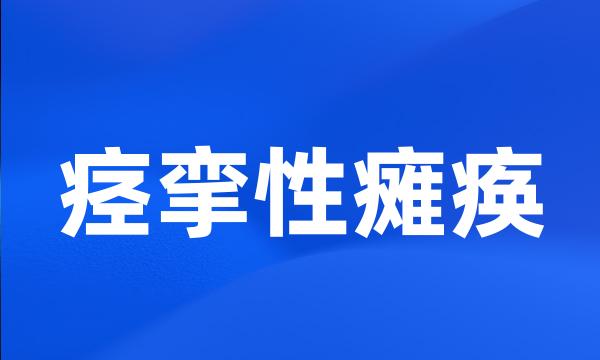痉挛性瘫痪
- 网络spastic paralysis;spastic paraparesis
 痉挛性瘫痪
痉挛性瘫痪-
结果:5例于TIPSS后4周~4个月出现进行性下肢痉挛性瘫痪,1例伴上肢无力,1例伴有尿失禁。
Results : Spastic paralysis in the lower extremities occurred progressively during 4 weeks to 4 months after TIPSS in the five patients . Weakness of the upper extremities presented in one patient , and urinary incontinence was in another one .
-
随病情的进展,均出现四肢痉挛性瘫痪,肌力Ⅲ~Ⅳ级,肌张力呈折刀样增高,四肢腱反射亢进,两侧踝阵挛及Babinski征(+)。
As the disease progressed slowly , the patients presented with spastic paralysis of four extremities , reduced muscle strength ( 3 to 4 degree ), clasp-knife like of muscular tension , hyperactivity of tendon reflexes , ankle clonus and presence of Babinski sign .
-
结论:TIPSS术后出现进行性下肢痉挛性瘫痪、不伴有感觉障碍者应考虑HM。
Conclusion : Spastic paralysis with intact of superficial sensation in the lower extremity fol - lowing TIPSS should be considered as HM.
-
不伴有热带痉挛性瘫痪及HTLV-I相关脊髓病的HTLV-I感染性周围神经病
Peripheral neuropathy in HTLV-I infected individuals without tropical spastic paraparesis / HTLV-I associated myelopathy
-
细胞凋亡及sFas、sFasL在人嗜T-淋巴细胞病毒Ⅰ型相关性脊髓病/热带痉挛性瘫痪中的表达及其意义
The Apoptosis and the Expression of sFas 、 sFasL in Patients with Human T-lymphotropic Virus Type I-associated Myelopathy / Tropical Spastic Paraparesis
-
痉挛性瘫痪改良AshworthⅡ级以上者异位骨化发生率较高,统计学比较差异非常显著(P<0.01)。
There was a higher incidence of HO in the patients with spasticity above modified Ashworth grade ⅱ( P < 0.01 ) .
-
针药结合治疗中风后痉挛性瘫痪的临床观察
Clinical Effect on Spastic Paralysis after Stroke with Acupuncture and Medicinal Treatment
-
针刺治疗中风后痉挛性瘫痪的系统评价
Systematic evaluation of acupuncture for treatment of post-stroke spastic paralysis
-
痉挛性瘫痪的神经外科治疗:功能性选择性神经后根切断术
Neurosurgical approach to spasticity : functional selective posterior rhizotomy
-
腹针治疗脑血管病后痉挛性瘫痪的疗效观察
Observation on therapeutic effect of abdominal acupuncture on spastic paralysis after cerebrovascular disorder
-
试论中风后痉挛性瘫痪病机及针灸取穴原则
Analysis on the Pathogenesis of Apoplectic Spastic-paralysis and the Principles for Selecting Acupoints
-
结论功能性脊神经后根手术是治疗下肢痉挛性瘫痪的有效方法;
CONCLUSION FPR is an effective treatment for spastic paralysis of lower extremities .
-
调督通阳针法治疗脑卒中后痉挛性瘫痪疗效观察
Observations on the Efficacy of GV-regulating and Yang-activating Acupuncture in Treating Postapoplectic Spasmodic Paralysis
-
基于中风痉挛性瘫痪患者报告的临床结局评价量表的信度、效度及反应度
Reliability , Validity and Response of Patient-Reported-Outcome Scale in Stroke Patients with Spastic Paralysis
-
泻阴补阳法治疗脑卒中后痉挛性瘫痪临床研究
Clinical Study on Treatment of Spastic Paralysis after Stroke with Yin-Reducing and Yang-Supplementing Therapy
-
颈交感神经节后纤维束切断治疗痉挛性瘫痪
Treatment for spastic palsy with superior cervical sympathectomy
-
方法将符合标准的60例脑卒中后痉挛性瘫痪的患者随机分为两组,治疗组30例,采用针刺夹脊穴治疗;
Methods 60 cases of spastic paralysis after stroke were randomly divided into two groups .
-
音乐干预结合运动疗法改善脑卒中后痉挛性瘫痪的临床研究
Clinical research for patients with spastic paralysis after stroke treated by music intervention combined with exercise therapy
-
目的:观察泻阴补阳法治疗脑卒中后痉挛性瘫痪的临床疗效。
Objectiv : To observe the clinical therapeutic effect of Yin-Reducing and Yang-supplementing on spastic paralysis after stroke .
-
目的:介绍针灸缓解卒中后痉挛性瘫痪状态的研究进展。
Objective To introduce progresses of studies on acupuncture and moxibustion for treatment of spastic paralysis after stroke .
-
目的:探讨腹针疗法对中风后痉挛性瘫痪的临床疗效。
Aim : To investigate the clinical efficacy of treatment of Abdominal Acupuncture on spastic paralysis after stroke .
-
针灸治疗中风痉挛性瘫痪疗效评定标准述评
Comment of the criteria for assessment of therapeutic effects of acupuncture and moxibustion on spastic paralysis of apoplexy
-
少数为痉挛性瘫痪或呈去脑强直状态,双侧锥体束征阳性。
Minority goes to convulsion sex breaks down or be shown cerebral rigidity condition , bilateral cone bundle ask for masculine gender .
-
目的探讨胫神经缩窄术治疗下肢痉挛性瘫痪、矫正内翻马蹄足的手术适应证、手术方法。
Objective To explore indication and approaches of neurotomy of tibial nerve for the treatment of the talipes equinovarus and spastic paralysis .
-
离心性收缩和负重状态下的等长收缩在上肢痉挛性瘫痪功能训练中的作用
The effect of isometric exercise carrying the weight of body and centrifugal contraction exercise on the motor function of spastic upper limbs
-
用脑立体定位技术,选择性毁损左侧锥体束,造成大鼠中枢性痉挛性瘫痪模型。
Equipped with stereotaxic technique , electrolytic destroying of the left side pyramidal tract was carried out to create central spastic palsy model .
-
临床上痉挛性瘫痪是中风病患者常见的后遗症之一,患侧肢体往往表现为拘紧僵硬。
Clinically , spasticity is a common sequelae of stroke patients , one of the performance of the affected limb is often detained tight rigid .
-
方法:从临床研究和机理研究等方面对近10年来针灸缓解卒中后痉挛性瘫痪状态的文献进行综述。
Methods The literature about acupuncture and moxibustion for treatment of spastic paralysis after stroke in recent ten years were reviewed from the clinical and mechanism studies and so on .
-
以期探索出一种对脑卒中后痉挛性瘫痪行之有效的治疗方法,从而提高针灸治疗中风偏瘫的临床疗效及临床研究的科学性。结论:腹针疗法可能是中风后痉挛性瘫痪的有效方法。
Methods : 60 case of spastic paralysis after stroke were randomly divided into two groups . Conclusion : Abdominal Acupuncture treatment may be an effective way in curing spastic paralysis after stroke .
-
中枢性瘫痪,又称上运动神经元性瘫痪,或称痉挛性瘫痪、硬瘫。是由于大脑皮层运动区锥体细胞及其发出的神经纤维&锥体束受损而产生。
Central paralysis , also known as upper motor neuron paralysis , or spastic paralysis , rigid paralysis , is due to the damage of the pyramidal cells in the cerebral cortex motor area and the nerve fibers from the pyramidal tract .
